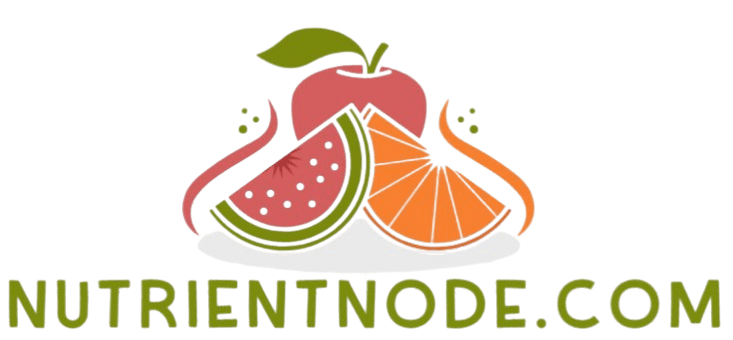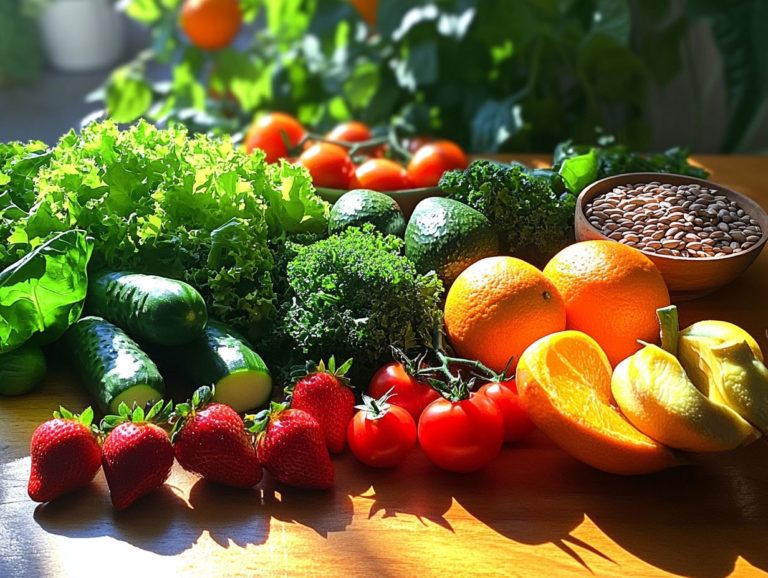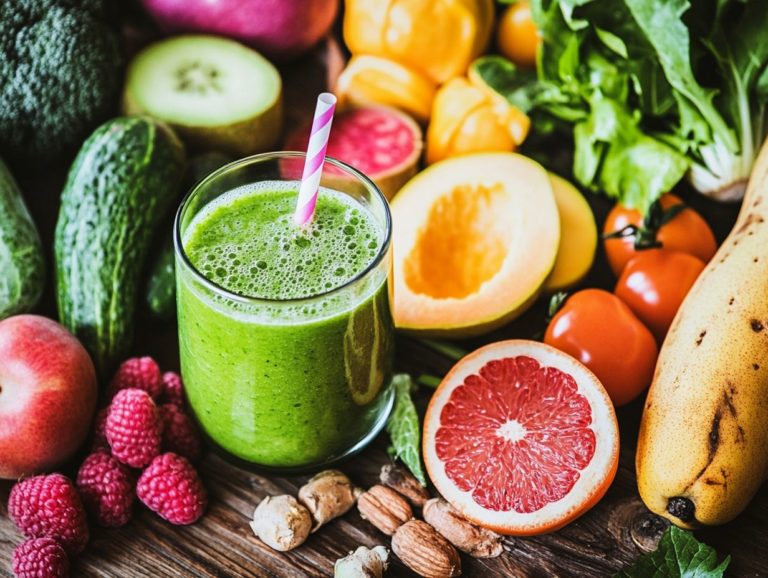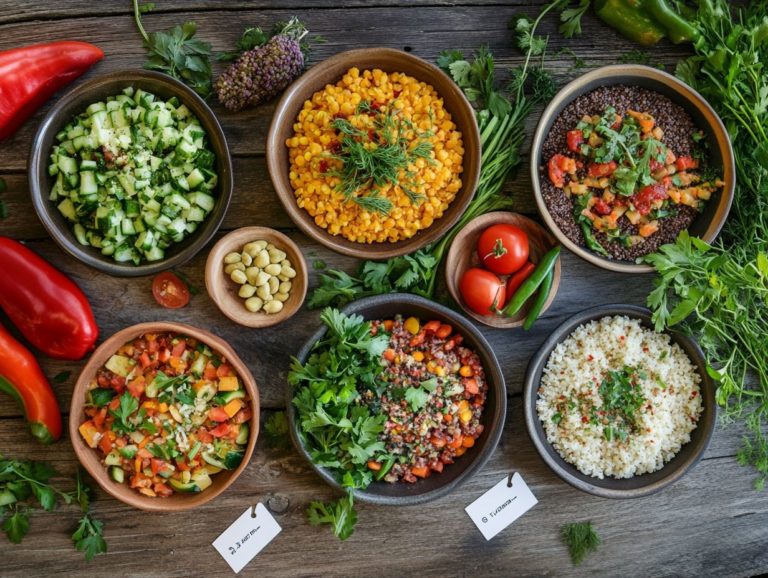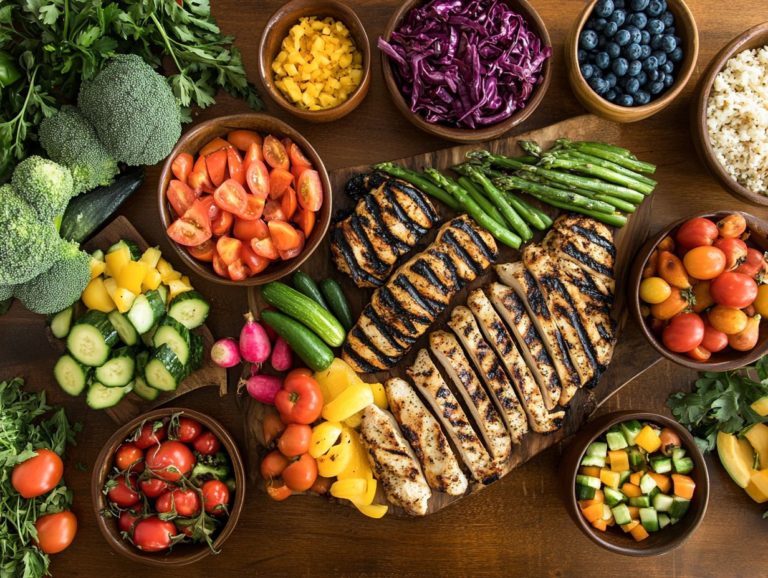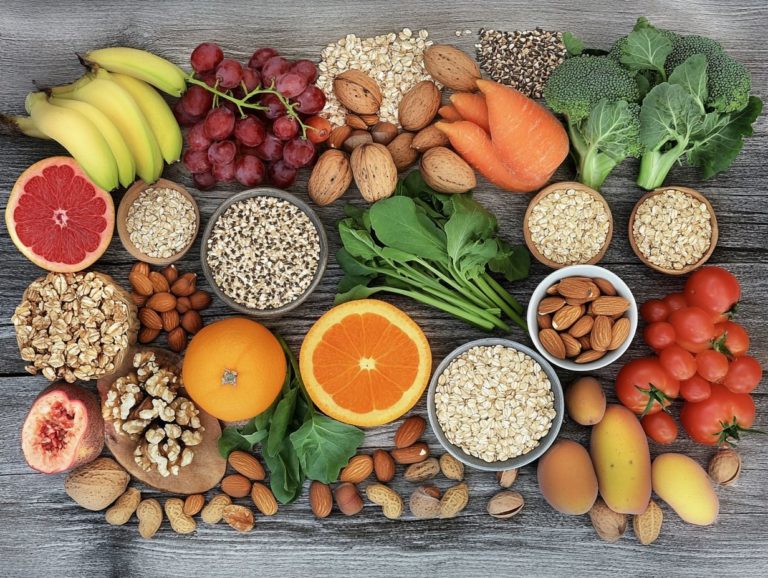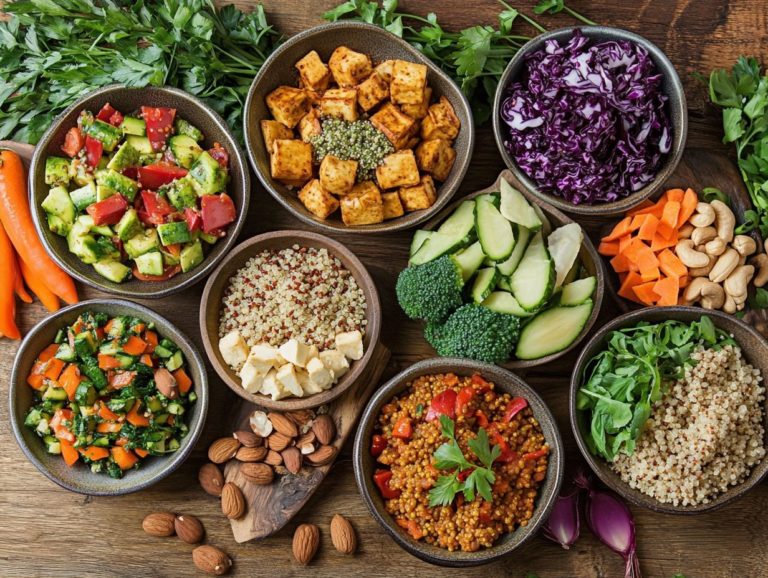The Basics of a Nut-Free Diet: What You Need to Know
Nut allergies are becoming increasingly prevalent, impacting individuals across all age groups. Grasping the causes and symptoms of these allergies is essential for navigating daily life safely and confidently.
This article explains the importance of a nut-free diet. It highlights benefits for those with allergies and risks for those without. It identifies foods to avoid, offers guidance on how to read labels effectively, and suggests delightful nut-free alternatives.
By the end, you will be equipped with the knowledge to manage nut allergies with ease and assurance.
Contents
Key Takeaways:

Avoiding nuts is a must for anyone with allergies! Understanding the causes and symptoms can help prevent severe reactions.
A nut-free diet is essential for those with allergies, but it can also benefit overall health. However, it may pose risks for those without allergies if not followed properly.
Knowing common sources and hidden ingredients can help you avoid nuts. Reading labels and finding nut-free alternatives and recipes can make following a nut-free diet easier.
Understanding Nut Allergies
Grasping the nuances of nut allergies is essential for you and your loved ones, as these allergies can precipitate severe allergic reactions. Peanut allergies, in particular, alongside other nut allergies, are gaining recognition, with tree nuts and peanuts frequently cited as common triggers.
Symptoms range from mild hives to severe reactions, including difficulty breathing. Therefore, it s vital to comprehend the complexities surrounding these allergies.
The FDA has stepped in with guidelines, including the Food Allergen Labeling and Consumer Protection Act. These guidelines are designed to assist you in identifying potential allergens in the foods you consume.
Causes and Symptoms
Peanut and nut allergies can develop due to a blend of genetic and environmental factors, leading to a variety of allergic reactions.
Genetic predisposition is a significant factor; if you have a family history of allergies, you are more likely to experience these sensitivities yourself. Environmental triggers also come into play exposure to peanuts at an early age or cross-contamination during food preparation can heighten the risk of developing these allergies.
The symptoms tied to nut allergies can vary widely, from mild rashes and hives to severe responses such as a life-threatening allergic reaction. Recognizing these symptoms quickly can save lives. Don t take chances when it comes to allergies!
The Importance of a Nut-Free Diet
Embracing a nut-free diet transcends mere dietary preference; for individuals with nut allergies, it s an essential commitment to safeguarding against potentially life-threatening allergic reactions.
For those affected, this lifestyle entails meticulously avoiding all sources of nuts both peanuts and tree nuts to prioritize safety and well-being. It requires a keen understanding of food labels and the art of crafting nut-free meals.
Being prepared with emergency medications, such as epinephrine auto-injectors (an emergency medication used to treat severe allergies), is crucial for any unforeseen allergic incidents.
Benefits for Those with Allergies
A nut-free diet presents a multitude of benefits for those with nut allergies by effectively preventing allergic reactions while promoting overall health.
By avoiding nuts, you can significantly lower your risk of severe allergic responses. In fact, the Asthma and Allergy Foundation of America notes that over 1.5 million individuals in the United States are affected by this issue.
Embracing this dietary lifestyle can also lead to improved digestion and enhanced energy levels. Many find that eliminating certain allergens allows them to feel lighter and more vibrant throughout the day.
Anecdotal evidence supports the idea that those who switch to nut-free alternatives often experience fewer gastrointestinal issues and a greater overall sense of well-being. This reinforces the notion that mindful eating can indeed pave the way to a healthier lifestyle.
Stay informed and protect yourself from nut allergies today!
Potential Risks for Those Without Allergies

While a nut-free diet is crucial for those with nut allergies, it can pose potential risks for individuals without such allergies. One major concern is nutritional deficiencies.
You might miss out on essential nutrients, like healthy fats, proteins, and vitamins that nuts provide abundantly. Nuts are a rich source of omega-3 fatty acids, a type of healthy fat important for your body, as well as important minerals like magnesium and zinc.
You can still achieve a balanced diet by incorporating alternative sources of these nutrients. For instance, consider:
- Seeds
- Avocados
- Olive oil
These are excellent substitutes for healthy fats. Legumes, quinoa, and dairy products can provide the necessary protein.
By being mindful and selecting a diverse array of foods, you can ensure optimal nutrition while keeping nuts off your plate.
Foods to Avoid on a Nut-Free Diet
Know the foods to avoid, including all types of tree nuts and peanuts. Many products hide these ingredients, so stay alert!
Common Sources of Nuts
Nuts are often found in snacks like peanut butter and almond milk. Baked goods may also contain tree nuts, so check labels carefully!
Many health-conscious individuals are increasingly turning to nut-based butters, like cashew and hazelnut spreads, which have become essentials in countless kitchens. Beyond these recognizable staples, processed foods often incorporate a variety of nuts, like pistachios and walnuts, hidden in trail mixes, granola bars, and even savory sauces.
Nut oils, such as walnut and macadamia, enrich your cooking with deep flavors and health benefits. With the rise of vegan and gluten-free diets, nuts are more prominent than ever in today s eating habits.
Hidden Nut Ingredients
Hidden nut ingredients can often lurk in various food products, making it essential for you to be vigilant when examining food labels.
For example, nut extracts like almond or hazelnut essence can unexpectedly appear in baked goods and flavored oils. Certain sauces, especially those used in Asian cuisine, may contain peanuts or tree nut derivatives that could easily be overlooked.
Familiarize yourself with ingredient lists and allergen disclosures. By actively seeking out these hidden components, you can better protect yourself and enjoy your meals without worry.
Always keep in mind that even trace amounts can trigger severe reactions, so maintaining a proactive approach to food labeling is vital for your safety.
How to Follow a Nut-Free Diet
Adopting a nut-free diet requires careful planning and a solid understanding of nut-free cooking techniques. This approach is vital for your safety and enjoyment!
Reading Labels and Identifying Nut-Free Options
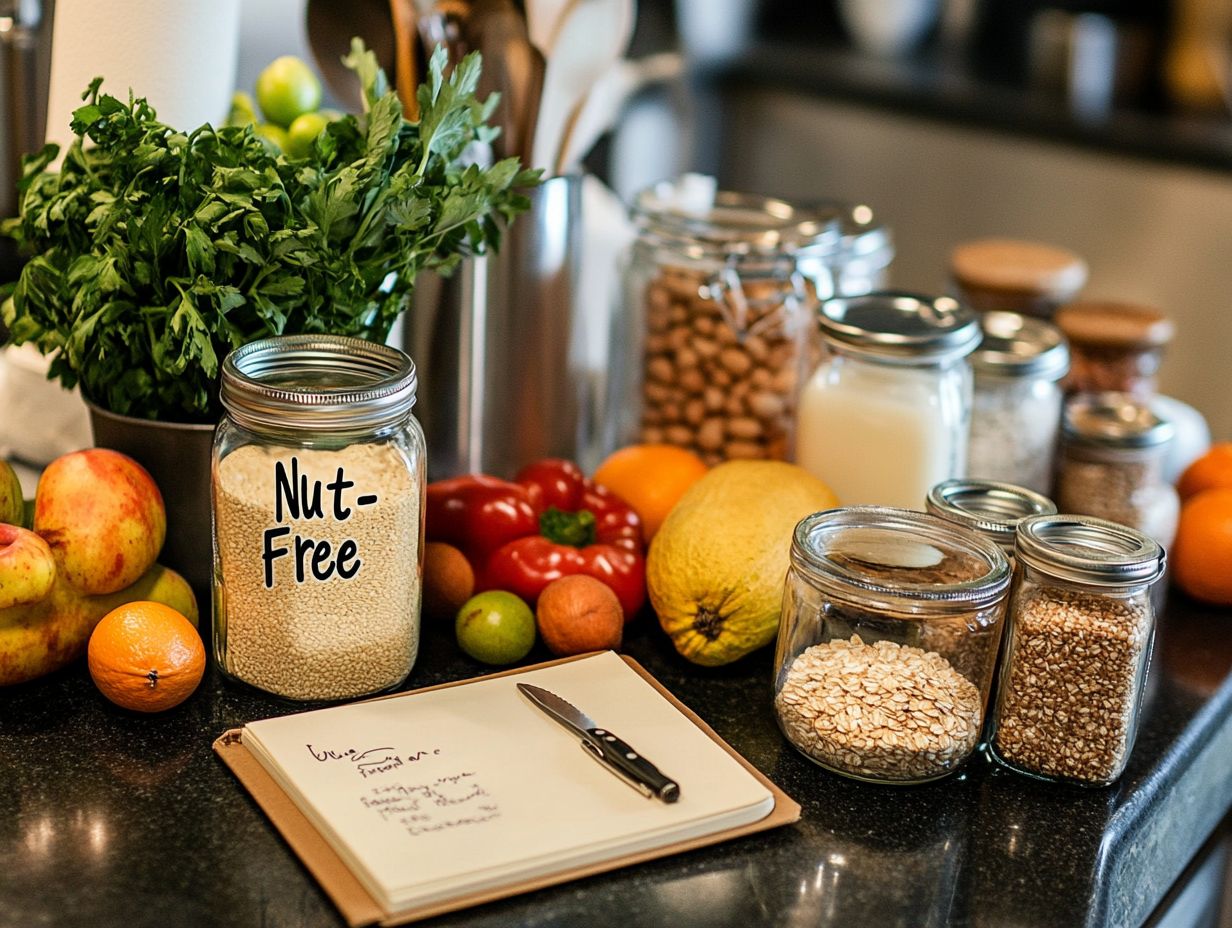
Reading food labels is an essential skill when you’re following a nut-free diet, allowing you to identify safe options while expertly dodging potential allergens.
To navigate food packaging effectively, look for specific terms that signal the presence of nuts, such as almonds, cashews, or hazelnuts. Don t overlook phrases like may contain traces of nuts either; they re crucial for your safety.
Ingredient lists reveal a lot; pay close attention, as items listed at the top are present in larger quantities. Learning to spot certified nut-free logos can enhance your ability to make safer choices.
By being vigilant about food labels, you enable yourself to significantly reduce the risk of accidental allergen exposure, ensuring a safer and more enjoyable dining experience.
Alternatives to Nut-Based Foods
Exploring nut-free alternatives is crucial for anyone with nut allergies. This approach guarantees a diverse diet that doesn t sacrifice flavor or nutrition.
Nut-Free Substitutions and Recipes
If you or someone you know has nut allergies, nut-free recipes are crucial! They offer exciting alternatives that burst with flavor.
In fact, these recipes can be wonderfully diverse, spanning from hearty meals to indulgent treats. One savvy approach is to explore seeds like sunflower or pumpkin seeds as substitutes for nut-based ingredients. Not only do they bring a satisfying crunch, but they also pack in essential nutrients.
Incorporating ingredients like coconut or soy can elevate the taste profile. This ensures that nobody feels like they re missing out on the deliciousness. When preparing meals, consider adding spices and herbs to enhance the flavors, creating that satisfying depth often associated with traditional cooking.
With a touch of creativity, you can relish a variety of dishes that everyone will enjoy, irrespective of food restrictions.
Frequently Asked Questions
What is a nut-free diet?
A nut-free diet is a type of diet that excludes all types of nuts, including peanuts, tree nuts, and nut-based products. This diet is typically followed by individuals with nut allergies or those advised to avoid nuts due to health reasons.
Why do some people need to follow a nut-free diet?
Some people with health conditions may also need to avoid nuts to prevent severe allergic reactions. Conditions like Crohn’s disease or diverticulitis may necessitate this dietary choice to reduce inflammation in the digestive system.
What types of foods should I avoid on a nut-free diet?
It’s best to steer clear of all types of nuts, including peanuts, almonds, cashews, and pistachios. Avoid nut-based products such as peanut butter, almond milk, and nut-based flours. Always check food labels for potential allergens.
What are some alternatives to nuts?
There are plenty of alternatives to nuts that you can include in your diet. Options like seeds, such as pumpkin or sunflower seeds, soy products like soy milk or tofu, and legumes (beans and peas) are great substitutions. You can also use seed or oat-based flours as substitutes for nut-based flours in baking.
Is it possible to have a well-balanced diet without nuts?
Yes, it is possible to have a well-balanced diet without nuts. While nuts are a good source of healthy fats, protein, and other nutrients, they are not essential. You can obtain similar nutrients from other sources, such as seeds, legumes, and whole grains.
Yes, there are several hidden sources of nuts that you should know about when following a nut-free diet. Some unexpected products that may contain nuts include salad dressings, granola bars, and some sauces.
Always read food labels carefully and ask about ingredients when eating out to avoid any accidental consumption of nuts.
A nut-free diet is a type of diet that excludes all types of nuts, including peanuts, tree nuts, and nut-based products. This diet is typically followed by people who are allergic to nuts or those advised to avoid nuts due to health reasons.
Why do some people need to follow a nut-free diet?
People with nut allergies may need to follow a nut-free diet to prevent severe allergic reactions. Some people with health conditions, like Crohn’s disease or diverticulitis, need to avoid nuts to reduce inflammation in their digestive system.
What types of foods should I avoid on a nut-free diet?
Be careful with all types of nuts, including:
- Peanuts
- Almonds
- Cashews
- Pistachios
Also, avoid nut-based products such as peanut butter, almond milk, and nut-based flours. Always check food labels for potential allergens.
What are some alternatives to nuts?
There are plenty of alternatives to nuts that you can include in your diet. Some great options include:
- Seeds, like pumpkin or sunflower seeds
- Soy products, such as soy milk or tofu
- Legumes, like beans or lentils
You can also use seed or oat-based flours as a substitute for nut-based flours in baking.
Is it possible to have a well-balanced diet without nuts?
Yes, it is possible to have a well-balanced diet without nuts. Nuts are a good source of healthy fats, protein, and other nutrients, but they are not essential. You can get similar nutrients from other sources, like seeds, legumes, and whole grains.

